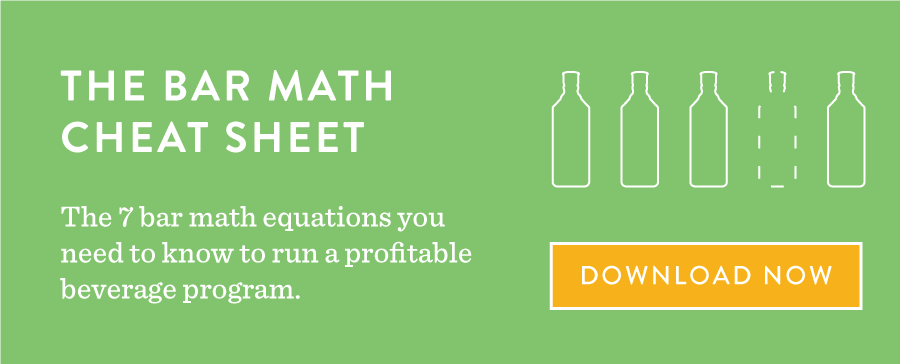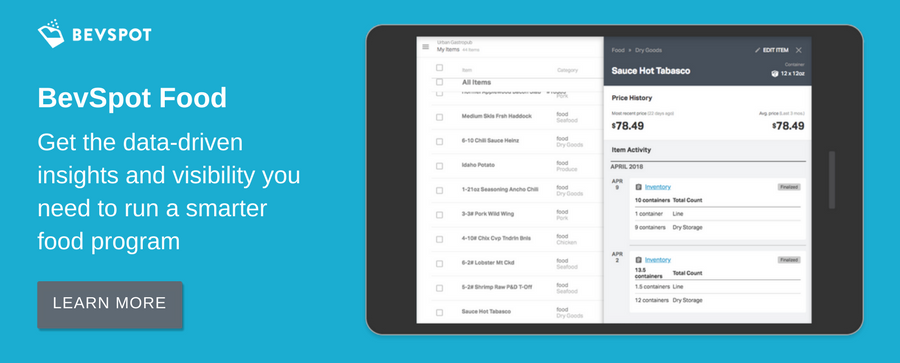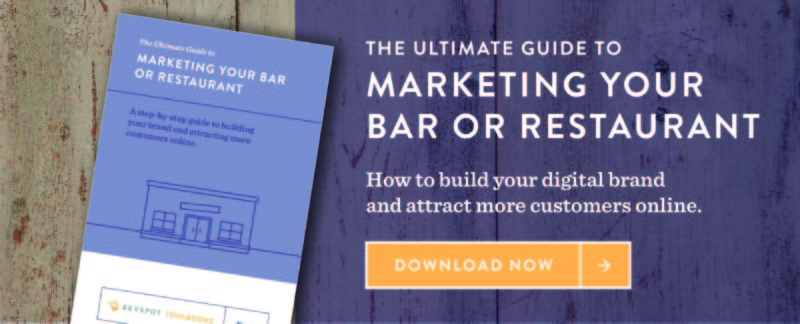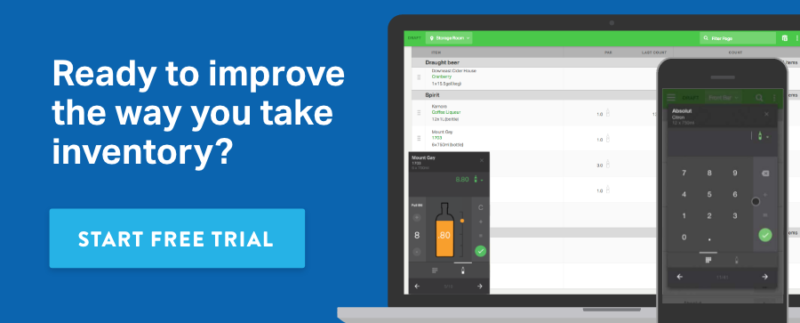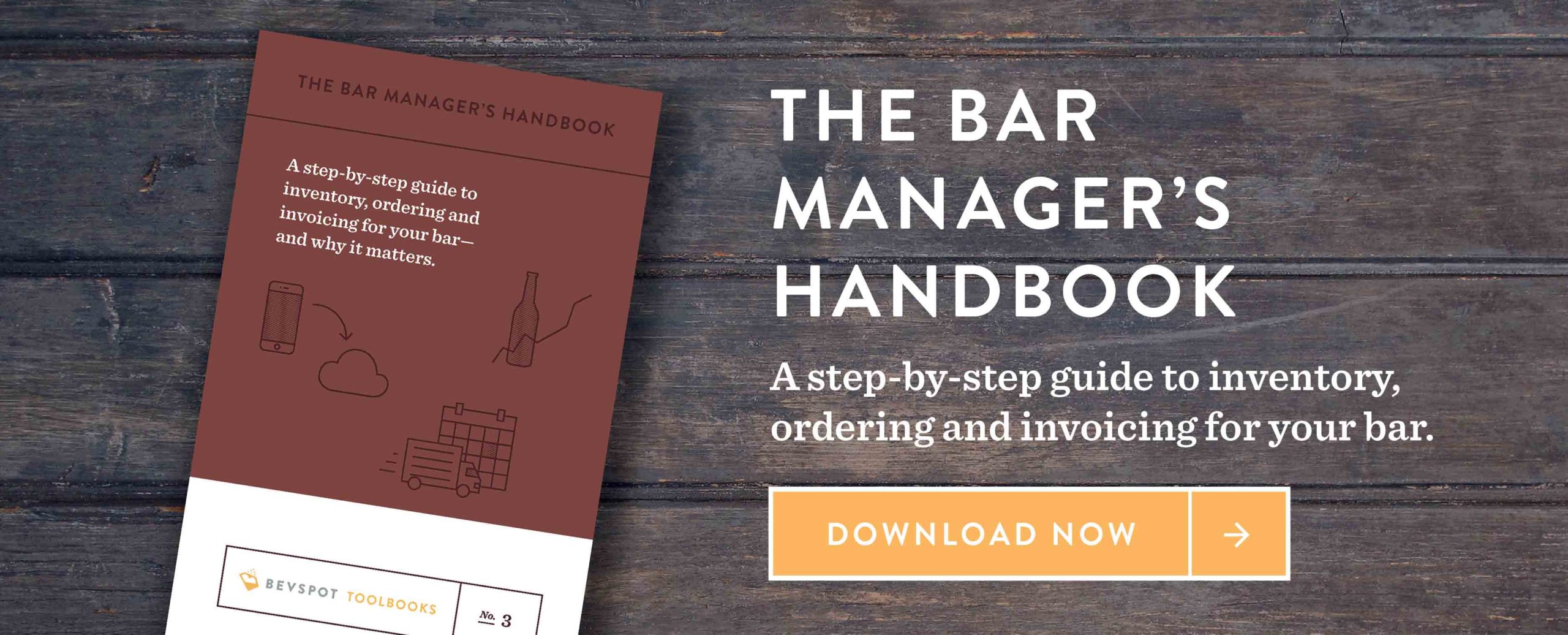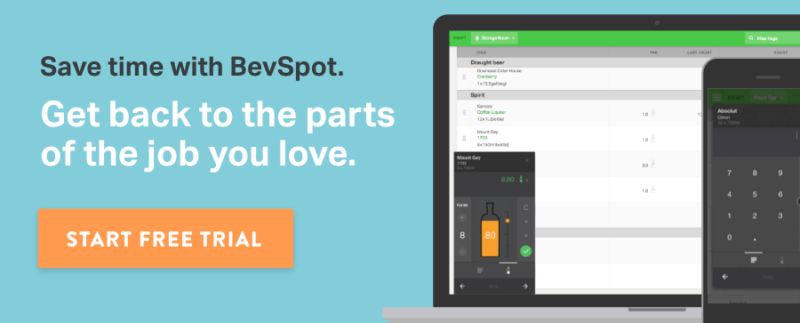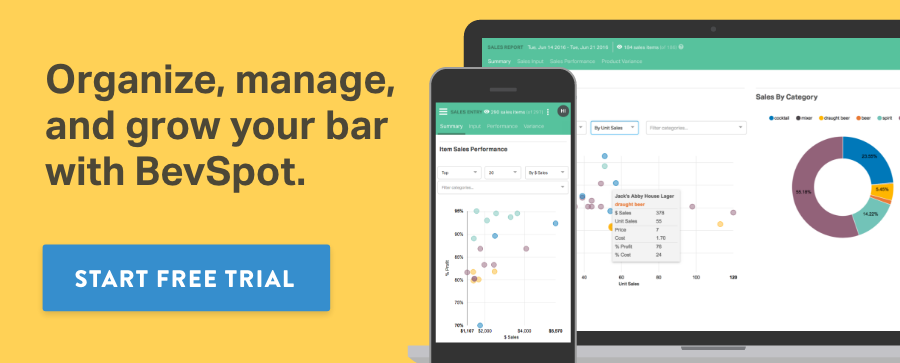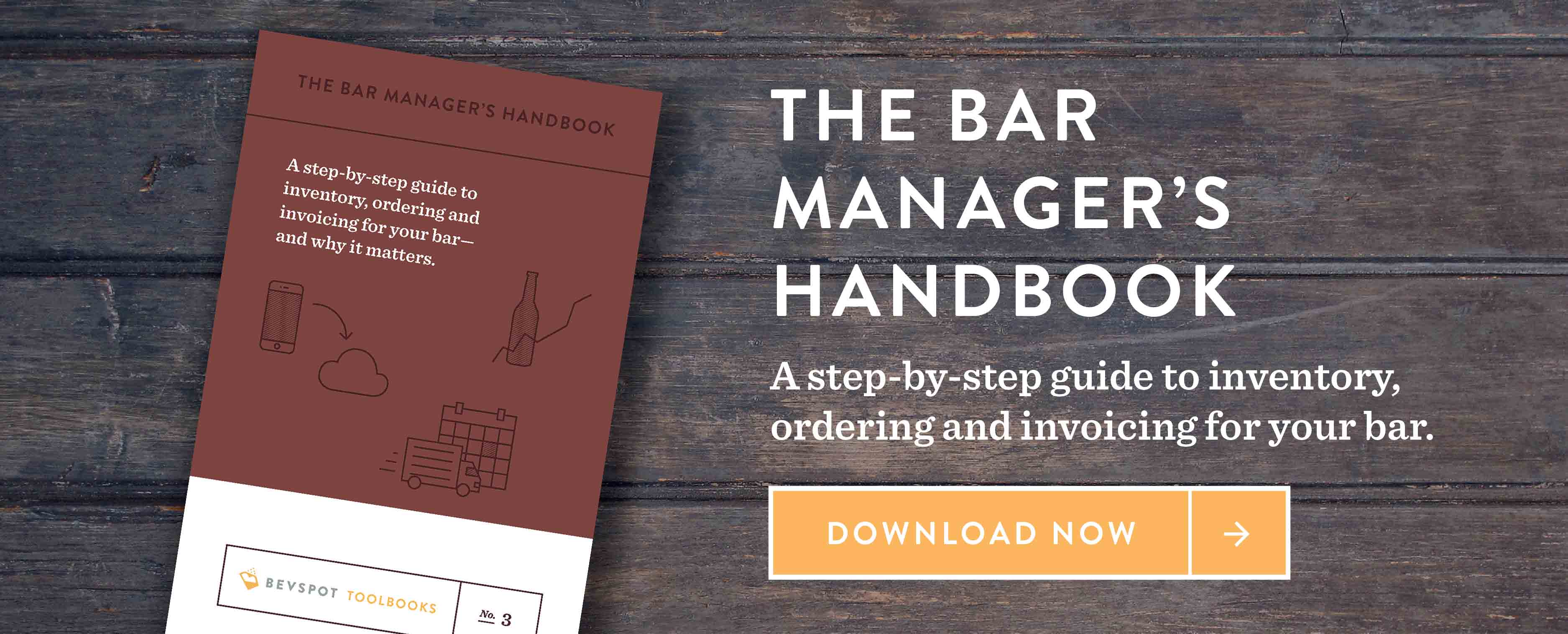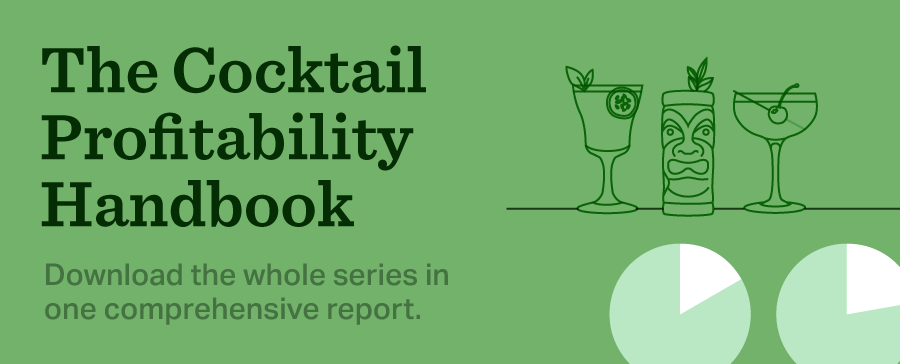Product Mix Report: What You Are Looking At and Why
Here’s how you should be looking at your product mix report.
Nowadays, every restaurant or bar has its own digital POS (point of sale) system. Whether it be Micros, Breadcrumb, or any other of hundreds, chances are you’re using it to record all of your sales. For example, every time someone orders a Bud Light, your bartender enters it into the bar inventory system before serving them their desired beverage. Periodically, you will run a report from that POS system that is known by many names: PMIX (product mix report), item-level sales, etc.
This report will break down the performance in sales on each item you carry. The numbers from the report are fundamentally used as a health check for your bar or restaurant program. But what metrics are you really looking at? And how often should you be checking them? Let’s get into it.
Interpreting Sales Performance From Your PMIX
While the actual format and output of your report will vary widely depending on your actual POS system, the most common item-by-item numbers that a PMIX report should contain include:
- Quantity of each item sold
- Percentage of total revenue from sales of that item
- Number and value of voids or comps
Newer, cloud-based POS systems will often offer viewable reports within the software itself. In contrast, many older systems like Micros or Aloha will force you to export the report, often in an inflexible and limited format such as a PDF.
Some systems can get quite extensive in their reporting. Breadcrumb, for example, offers sales data specific to each individual bartender or server.
Some systems can also provide the cost of goods sold on every product, though this is rare. However, it can be a huge pain to manually enter in the cost of each product into a POS system. In order to determine your individual costs, you’ll usually have to do the math yourself or look to bar inventory software to help you track it.
How Often to Check Your Sales Numbers
Most commonly, PMIX reports are run for either weekly or monthly time periods. But this frequency can vary depending on the size and nature of your bar and its program.
For example, smaller bars will often to sparse out their reports to monthly intervals, so they can gather a larger pool of data and prevent overreacting to temporary shifts in performance. In contrast, larger bars that innately have more data often run reports weekly in order to more precisely track performance and quickly identify shifts in sales trends.
How to Use Insights From Your Product Mix Reports
Analyzing your PMIX reports can help you identify your best and worst selling products. This will help you make critical decisions around your menu offerings, like what to feature on happy hour specials, or what to include in a cocktail recipe.
You can also utilize your reports to gain deeper program knowledge, like identifying product variance and setting inventory pars for ordering product.
Schedule 15mins to chat with a product specialist
Start a FREE Trial Today! BevSpot offers full product education and account setup for all customers! No card Information needed!
Tips on Gaining Regular Customers for Your Bar
Incentive programs, customer data, and a classic hidden bartender trick encourage customers to be more than just one and done…
Your regular customers are some of the most important people who pass through the doors of your establishment. They visit more often, spend more as a result, bring new customers, and act as champions for your bar both online and in the local neighborhood. These are a few tried and true methods for keeping tabs on, taking care of, and attracting your best and most loyal customers.
The Little Black Book
We’ve mentioned before that bartending is something of a mysterious job. For all the science and exact measurements and data you pour into it, you can’t remove the noir quality of life behind the bar. One such mixological McGuffin is the bartender’s little black book.
Bartenders have long kept notes on not just favorite recipes but on customers as well. Physical descriptions names, favorite drinks, and facts about their lives are all types of entries that can make their way into the black book. This allows bartenders to strike up conversations, suggest new drinks, and generally make their best customers feel welcome and happy to come back again and again.
We talked to Jon Karel, owner and manager of Buffalo Proper, about his bartenders and their use of the little black book. “Most of my bartenders carry a little black book. We try not to use it so much for recipes, we rely on 150 years of cocktail history, so it’s more about being exceptional rather than innovative.”
When asked about how they attract and keep regulars in the bar, he mentions that one of their key strengths is low staff turnover. Every bartender, including Karel himself, works full-time behind the bar. Keeping his employees happy and working let’s them focus less on their next paycheck and more on being excellent bartenders. “One of our core beliefs is: if we’re here to service the community, we should service the community. If we can’t remember someone that’s in every week or someone that gives us a nice tip, we’re missing something.”
Leveling Up Through Data
Like most things nowadays, even the lore filled black book has made its way into the information age. Products like Upserve’s Guest Book, a digital black book that delivers customer data by analyzing point of sale data like payments, orders, reservations and the like. With it, bartenders can see thing like what their customers favorite orders are, when they are most likely to visit, how well they tip, and what they are likely to spend on each visit.
Beyond keeping track of individual customers programs like Upserve allow you to keep track of trends as well. Checking which of your promotions do well, when customers are likely to visit and what they are likely to order, allows you to craft your experience to promote the growth of new customers and a larger base of loyal regulars.
While Karel and his stable of bartenders do take advantage of services like OpenTable, they also have their own intra-employee network with which they can pass along notes on customers and preferences. “We try to pass along info about certain customers, and we like to encourage customers to have a relationship with multiple bartenders, so they don’t need to have ‘their guy’ if a certain bartender isn’t on that night.”
Karel also points out that it’s possible to go too far with data, and at the end of the day the most important thing is that the drinks taste good. “We want to know people, but we don’t want to know everything about them to the point it becomes creepy or invasive.”
The First Rule of Mug Club
While the bartender’s little black book and POS services like Upserve’s Breadcrumb are certainly extraordinarily useful in keeping tabs on and cultivating regulars, they definitely aren’t the only way to do it. When last we interviewed folks at Gene McCarthy’s about their trivia night, they also answered our questions about their Founder’s Mug Club.
The Founder’s Club at Gene McCarthy’s was a pay-in membership type program. In exchange for a fee, a limited number of customers that paid into the program (McCarthy’s has over 100 Founding Members) receive a discount on drinks every time they come in, served in their own etched glass beer mug labeled with their name. This creates incentive for customers to return to their bar, because they’re not only already invested, but they also have exclusive deals and, due to repeat business and their names literally being on the mug, staff that know them.
This is an especially great tool for new establishments. Hamm and Fattey’s Beer Company in Hamburg, New York uses the mug club to great effect, offering nearly a dozen benefits and selling out almost instantly upon their opening a few months ago. This provided them with a Day One customer base, and a booster shot of startup money to get the business going.
The regular customer is the champion of your bar. They spend their time with you repeatedly over any other establishment, they bring friends, and the advertise freely by talking you up on social media or by word of mouth. Making the extra effort to know who they are and what they like will keep them coming back for more, and it can be as simple as taking notes or checking in on a custom POS app. At the end of the day though the best thing you can do is focus on excellence, and making your bar the best it can be.
Schedule 15mins to chat with a product specialist
Start a FREE Trial Today! BevSpot offers full product education and account setup for all customers! No card Information needed!
5 Red Flags That Your Bar Is In Danger of Failing
Bars close for many different reasons, but bars on the path to failure often come with warning signs.
One of my experiences came loaded with red flags. From damaged upholstery to broken equipment to bouncing paychecks, if there was ever a business that was failing, that one was it. It was a lesson well learned in knowing when something is working and when something isn’t. Going through that process and listening to others share their experiences, it only makes sense to share these red flags with you, so you can prevent your own business from failing and be more aware of how your bar is actually doing. I asked Dave Bertelo, a business-savvy longtime general manager and bar owner, for some insight of his own about what creates bar failure. Between the two of us, we came up with five red flags to look for…
Red Flag #1: Poor Financial Organization
This one can be a tough one. Restaurants and bar run a tight profit margin as it is. From Dave, “Restaurant/bar failure is often hard to see coming. The difference between profitable and being in the red is often the difference of $0.05 for every dollar the place takes in. Bars run on such slim margins that a bad winter or a fire can be devastating enough to close the doors.”
Keeping track of finances is a pain, a necessary pain. Every penny spent matters. Not having an organized record of expenditures and sales is a red flag. If you aren’t going to keep track of your finances, your bar will sink. End of story. This involves a record of paychecks, checks to distributors, sales, inventory and more.
Too many owners and managers have this idea that money is only cold cash or money in the bank—they forget the cost of their liquid inventory. Booze is money. A bar not keeping track of its finances in all forms is a bar losing money.
Red Flag #2: Undercapitalization
I’ve overheard people talking about how easy it is to open a bar and make quick money. Unless you have some kind of magical power, that’s seldom the case.
I like what Dave had to say on the subject: “The biggest cause of early bar failure is undercapitalization. Bars that didn’t do their homework on what their costs would be can be hemorrhaging money. Even if they did do their costs right, an owner needs to imagine a minimum of their first six months as if no customer walks in. If you do everything right, staff just right, can you keep buying food, paying that staff, paying rent and utilities for months without a single customer coming in for half a year?”
As we said in the above red flag, financial issues are a problem, and if you aren’t setting yourself up for success before you even open, you won’t last long. Really get to know the costs involved in your business.
“Some people don’t acknowledge [their mistakes] and hang on to something that is wrong.”
Red Flag #3: Declining Standards
Is the quality of your bar going downhill? The upholstery is in need of repair. The walls need a new coat of paint. Only one stove is working. The quality of toilet paper, napkins, and food deliveries have gone down. One or two things being changed isn’t necessarily something to be worried about, but broken equipment and the product being cheapened while the prices remain the same should give cause for alarm. One way to deal with this issue is to get creative instead of get cheap.
I’ll let Dave finish this one out: “Cutting quality—this usually says it all. There is a difference between lowering cost of your products and buying cheap. When it come to food, as opposed to just buying the cheapest ‘X’ available, try a new dish that better utilizes a cheaper cut of meat, is more vegetable heavy, or better utilizes products you already use. On the beverage side, stuff like canned juices and cheap liquor are noticeable, as is lowering the amount of alcohol. Again that doesn’t mean the price of a bottle is everything. There are $15 whiskeys that people enjoy more than $100 bottles. And just like the food I have had success in how we have used those cheaper items, such as a wine that wasn’t great as a glass pour, made a sangria that was like printing money.”
Red Flag #4: Disconnected From Community
Dave and I have talked about this one multiple times. Location matters. Who works and lives around your bar matters. Do you have a lot of 9-5 businesses around? You’re going to want to capitalize on the lunch market and happy hour. Don’t be serving dishes that take 15-20 minutes to cook dominate your lunch menu. Time is money and if people don’t have time for your product, you’re out of money. As businesses focus more on employee happiness, many a company plans outings for their employees. Know the clientele and what they want.
Per Dave: “They can correct this with a change, sometimes just pricing or hours of operation. Other times it takes a whole new concept. It can be that your physical layout is killing you. This is when you are really only selling booze, but 50% of your physical location is dedicated to a high end kitchen because you thought you would be a fine food spot. Some people don’t acknowledge this and hang on to something that is wrong.”
If you aren’t willing to learn and adapt to change, so long and good bye.
Red Flag #5: Apathy
Dave put it simply, “Ultimately, there is one thing that is a sign of impending failure, is a guarantee of failure, apathy. An owner who doesn’t care creates a space where staff don’t care, and those will make guests not care… then you’re closed.”
Running a business is stressful, but it should give you happiness too. If you aren’t willing to eat, sleep, breathe your business and give it good life, your business will not last. Nobody starts their job not caring about where they are and what they do, that comes from the top down not doing their job and being apathetic. If you notice things are starting to not be done or call outs increase and staff leaves, someone somewhere in the business is bringing things down.
Fix the problem before the toxic apathy really sets in or you’ll get a reputation as a place no one wants to work. Nothing kills a business like no one wanting to work there, and then the skeleton crew left gets overworked and customer service falters. The power of social media is real and people use it to let others know about their experiences in all areas. Take care of your bar and your people. Don’t let this be the reason you failed.
Got stories of your own bar or restaurant closing? Lessons learned from a failure? Tell us in the comments below.
Schedule 15mins to chat with a product specialist
Start a FREE Trial Today! BevSpot offers full product education and account setup for all customers! No card Information needed!
America’s Most-Ordered Beer & Liquor Brands
Yearly Reports: 2015 // 2017 // 2018
Popular Beer and Liquor Brands Jan 1 – Jun 30, 2017
In the six months since we published our 2016 industry review, we’ve done a variety of drilldowns into bar & restaurant trends.
We’ve taken regional looks at the most popular beer and liquor brands in New York City, Boston, Chicago, Washington DC, Florida, and Texas. We’ve examined average pour costs for 28 classic cocktails. We’ve even taken a look at the most popular draft beers and cocktails.
Now that we’re halfway through 2017, we decided to revisit our 2016 report to see which beer and spirit brands are ordered the most by on-premises establishments. Here’s what the data shows.
The following material aggregates alcoholic beverage order data from U.S. BevSpot users during the first six months of 2017. These BevSpot users represent bars & restaurants numbering in the high triple-digits, located in 43 states plus the District of Columbia. All figures represent percentages of orders in dollar terms.
How to Weigh Draft Beer Kegs for Bar Inventory (with Free Spreadsheet)
Of all the ways to count kegs, using a keg scale to weigh these containers is by the far the most precise method.
But to get the most out of that keg scale, you still need an efficient liquor inventory workflow and an understanding of how to calculate your remaining product from those weight measurements. After all, knowing how to weigh a keg is one of the most useful skill every bar manager should possess.
We’ve built a free keg weight inventory spreadsheet to make this a whole lot easier. But if you still want a guide to the best keg inventory workflow—and an exploration of the calculations that our spreadsheet uses to calculate remaining product—read on.
Here’s how to count kegs in inventory using a scale in five steps:
1. Weigh Kegs When Full
This step is relatively intuitive. To know the proportion of liquid that remains in a partially depleted keg, you must first know how much liquid is in that keg when it’s full. So weigh each keg when full and record each full keg weight.
2. Weigh Kegs When Empty
When you measure the weight of a keg that contains liquid, the measurement you take reflects not just the weight of the liquid, but of the keg itself. Failing to take the empty keg weight (or tare weight) into account can cause you to overestimate the amount of remaining product.
Say you have a keg that weighs 10 kilograms when empty and contains beer that weighs 15 kilograms. If you fail to subtract the weight of the keg when taking inventory, you’ll erroneously think that you have 25 kilograms of product (67% more than the 15 kilograms that you actually have). As a result, you’ll run out of beer earlier than you expect.
To avoid this, weigh each keg when empty. (We’ll show how to use this when you calculate your remaining inventory in Step 4.)
3. Weigh Kegs During Inventory
Weigh each partially full keg, and record that partially full keg weight (often referred to as gross weight) alongside the full keg weight and empty keg weight of that same keg. This step is exactly what you’d expect.
Kegs that are completely full or empty, of course, count respectively as either one full container of product, or depleted product.
4. Calculate Remaining Volume in Each Keg
Here comes the geeky part.
To calculate the proportion of product that remains in each partially full keg, first take the partially full keg weight minus the empty keg weight. Then divide this by the full keg weight minus the empty keg weight:
% Product Remaining =
(Partially Full Keg Weight – Empty Keg Weight)
/ (Full Keg Weight – Empty Keg Weight)
Take the example from earlier. You have a keg that weighs 10 kilograms when empty, which contains 15 kilograms of beer (for a partially full keg weight of 25 kilograms). Say that keg weighs 30 kilograms when full.
% Product Remaining =
(25kg – 10kg) / (30kg – 10kg)
= (15kg) / (20kg)
= 75% of Product Remaining
In this example, a full keg contains 20 kilograms of beer once you subtract the weight of the keg itself. 15 kilograms remain. Divide 15 kilograms by 20 kilograms.
That means the keg is 75% full.
5. Log Inventory Totals in a System of Record
Now that you’ve calculated the amount of each product that you have in stock, it’s vital that you record your inventory totals in a robust system of record. Whether that’s a bar inventory spreadsheet or cloud-based bar management software, maintaining consistent inventory procedures and records is vital for:
- Detecting product variance, spills, and theft
- Measuring inventory usage
- Setting pars
- Calculating pour costs/margins
- Identifying which products sell well, and which don’t
Start a FREE Trial Today! BevSpot offers full product education and account setup for all customers!
Is Nostalgia Making a Comeback? Zima’s Return to Beverage Programs
What’s up with Zima popping up again?
Unless you’ve been camped out on the beach all summer ignoring all media, you’re no doubt aware of the limited re-release of Zima, the iconic clear beverage that Coors Brewing Company (now MillerCoors) introduced as a malt alternative or “malternative” to beer back in 1994, paving the way for others like Mike’s Hard Lemonade and Smirnoff Ice. Typically clear, sweet, and often citrusy, malt coolers offer a refreshing option especially for those trying to escape the heat, which is why the name “zima” was chosen: it means “winter” in Slavic languages, and was touted as “zomething different.”
If you were of legal drinking age in 2008, you may have gotten to taste the first incarnation of Zima before it was discontinued in the United States that October (although it never left Japan). After nearly a decade, why bring it back?
The Power of Retro
Retro culture has been big in recent years, with popular shows like Stranger Things, and now G.L.O.W., as well as products like Nintendo’s NES Classic Edition tapping into that 80’s and 90’s ethos. When fellow 90’s “clear craze” beverage progeny Crystal Pepsi made its own temporary comeback a year ago, no doubt MillerCoors took note of how the once-controversial beverage was suddenly flying off of shelves in 2016.
According to Zima senior brand manager Tristan Meline, “If you talk to someone who drank Zima in the 90’s, there is a great chance that they have a really fun story associated with it that takes them back in time. There’s also 90’s inspiration today everywhere you look, from fashion to food—and it’s clear the decade has made a comeback. This summer was the perfect time for our very own 90’s legend to return for a limited time.”
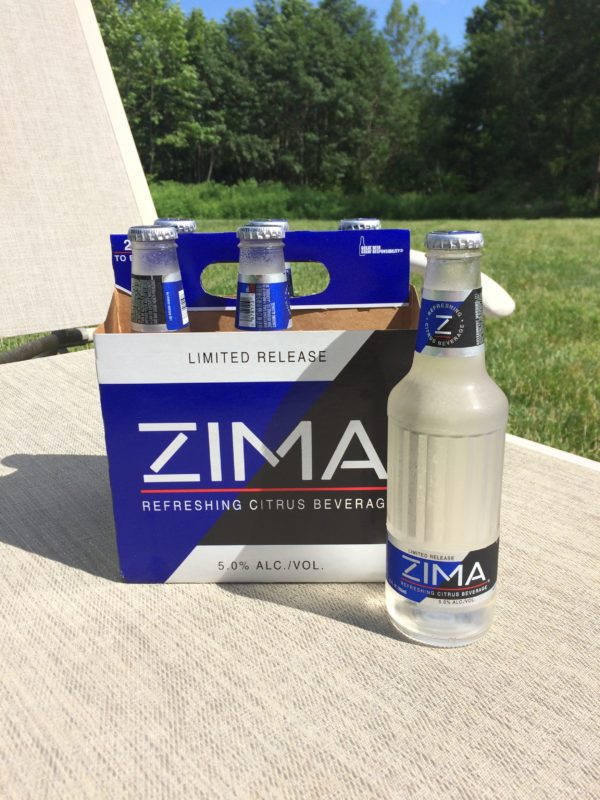
To capitalize on that 90’s retro feel, Zima has replicated the original bottle and carrier designs, its website looks like an authentic 90s site, its messaging has a snarky Gen-X tone, and there’s even an old school Zima chatbot you can troll on Facebook messenger. Enjoy them now, because Tristan says there are no plans to bring Zima back permanently, since MillerCoors doesn’t see it as a serious competitor to craft brews “or even other flavored malt beverages.” That said, they felt Zima was worth reviving on a limited basis because it’s “a little different and special.”
Revitalization in Action
Here in Providence, one popular West Side bar decided to throw a 90s party/charity event centered around Zima this past Saturday, July 8th: Nolan’s Corner Pub on Atwell’s Avenue raised $1,050 from Zima sales to give to Sojourner House, a shelter for victims of domestic violence.
“When I heard Zima was coming back, I immediately thought, ‘Of course we have to have a 90’s night at Nolan’s,’” says owner Brendan McCaughey. “The 90’s were my college years, when I was first introduced to drinking culture and ‘partying’, and Zima is a nostalgic part of that time in my life. The shameless marketing to Gen-Xers and ‘alternative’ younger crowd was omnipresent. While I wasn’t a big Zima drinker, it was almost always around at house parties for those first few years.”
Brendan pointed out that since Zima paved the way for malt beverages in general, it also helped to inspire the shandies and flavored beers that are so popular today. But mostly, he wanted to have fun with the retro theme while also supporting a great cause: “Since alcohol is inexorably linked to domestic violence and sexual assault, it seemed like a very appropriate charity to support,” he says.
Lasting Lessons from Time Travel
Ultimately, “the place was packed” with a good mix of 90’s/early 2000’s Zima drinkers, as well as younger crowds enjoying “borrowed nostalgia,” Brendan says. Tristan also shared that so far, the response to Zima’s comeback seems to be strong across all legal drinking demographics. It appears that the grunge decade’s appeal calls out even to those who were too young to really experience it fully (especially as governmentally-approved consumers of alcoholic beverages), and drinking throwback beverages enables them to experience those vintage vibes in a more tangible way. Probably bringing Zima back permanently would diminish the nostalgia effect, but for now, feel free to relive those clear, citrusy good old days with your guests.
Schedule 15mins to chat with a product specialist
Start a FREE Trial Today! BevSpot offers full product education and account setup for all customers! No card Information needed!
For more commentary on beverage trends, keep it tuned into the BevSpot blog by signing up for your own personal account. You’ll receive notifications on the latest articles as well as exclusive access to industry tools and guides.
Transitioning From Bartender To Bar Manager: 5 Traits That Will Help You Get To The Next Level
What do you need to know when looking to move up in the world of bartending?
When it came to transitioning from bartender to bar manager, it took me a few years, and some hard knocks to get me there. Like a lot of great bar leads and bar managers I know, I burned with a drive to do something and be something more. I worked long hours and came in whenever needed. I was always finding something else to improve in myself.
Even when I started running my own bar in a completely different city, I still strove to learning nearly everything. To help me learn how to do my job better, I started going to events being thrown by people all over in the industry. Getting to know some of the best bartenders and bar managers in the area, if not the country, I received great advice and input on what I was doing and how I could work with the limits I had.
Team Leader Breakdown
Thanks to those experiences, I learned what makes a bartender an ideal candidate to grow into a bar manager. In order to help my fellow bartenders, I also asked for input from a few fellow bar managers (and both former bosses of mine): Boston-based Tyler Lymer and Camille Cavan of Portland, OR’s Quaintrelle.
Camille’s natural eye for organization and background taught me the importance of a good garnish game as well as understanding the foundation of cocktails. Camille learned to bartend from Aaron Zieske and Jeffrey Morgenthaler. I have the utmost respect for her work.
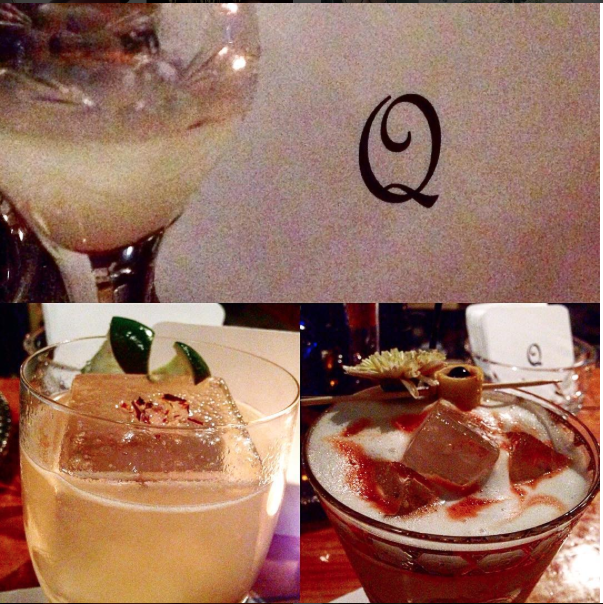
Tyler is one of the most thorough bar managers I’ve had the pleasure of working with—his attention to training was the most detailed I’ve ever experienced. Tyler was recognized by some peers as someone with potential and had his name thrown into the mix. Sometimes, all it takes is someone noticing you to give you a chance.
The Model Candidates
I’m honored to call Tyler and Camille friends. Between the three of us, here’s some traits we identified as ideal in bartenders wanting to become bar managers:
1. Ambition
They demonstrate a desire to grow—not just learning new technical skills but also taking on more responsibility. Anyone who expresses a desire to become more should be on an owner’s or manager’s radar and nurtured into a leadership role.
Camille said, “Being given credit, acknowledgment, and freedom has completely changed who I am as a bar manager/employee.” She also reminded me that sexism is still an issue for women, especially those looking to move up. “I hate to say it, but that is a constant struggle when remaining strong and knowing what you are doing is worth it, and that you have every right to be there.”
2. Curiosity
They are bar nerds. They want to know more about the numbers behind the bar. They want to understand how to properly cost drinks, how to do inventory, or why certain taxes come out of paychecks or the point of reporting tips.
Tyler had this to say, “I think that mastering roles is essential to development. I can tell if a person is a great candidate if they have a great foundation and understand the inner working of a bar (or are able to). The second part is, are they willing?”
3. Accountability
When corrected, they mostly own their mistakes or they ask how they can improve. They help hold coworkers accountable. They check in when something seems off behind the bar and bring forward solutions or want to know why the business operates a certain way.
4. Respect
They don’t bully others. They don’t engage in problematic behavior. If they disagree with management or someone else, they don’t hide from the issue, and don’t let it ruin the team or customer experience.
From Tyler: “I was lucky to have a GM that worked as a bartender in the past and ran cocktail bars prior to managing the entire operations. Because of that, he desired to be actively involved and present while still coaching me along the way.”
As Camille said above about sexism in the industry: it often isn’t a fair balance for women behind the bar. Sexism is a big issue, and for women bartenders looking to step into bar management, they often have to deal with inappropriate behavior from both customers and coworkers. Becoming a bar manager will mean being knowledgeable about various forms of discrimination and understanding how to deal with it appropriately.
5. Be A Good Person
They don’t engage in talking behind coworkers’ backs and focus on pulling their own weight. Part of management is leading a team and trusting in your team. Doing so with your coworkers and practicing compassion and kindness goes a long way into being a quality person and bar manager.
If you treat your customers well, why wouldn’t you expect the same of yourself and your coworkers Camille put it well: “Everyone has stuff. People have lives. Things happen. The more comfortable you are in your project, the happier you are; the healthier you are, the more likely your project will do well. It all trickles down.”
Final Notes
For all of us, it took hard work, some luck, time, and someone giving us a chance to prove our abilities beyond just bartending. Most of all, it required our awareness of who we are and showing how we were a good fit for the role. Special thanks to Tyler and Camille for their training of me and input. If you’re ever around where they work, you’ll experience some incredible cocktails and outstanding service.
Did we miss something? What else do you think makes a bartender a good fit for a bar manager? Let us know in the comments section below.
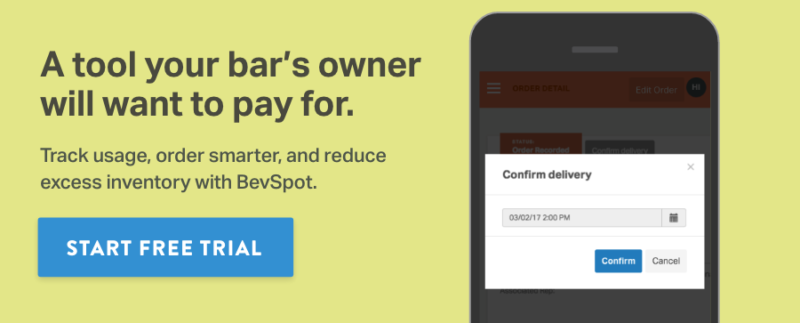
For more industry pointers and walkthroughs, stay tuned to the BevSpot blog by creating your own personal account. You’ll get notifications when we post new articles, as well as exclusive access to our industry tools and guides.
How Crafting Your Own Cocktail Ingredients Can Help Your Bottom Line
Creating your own craft cocktail
For a career already steeped in lore and mystique, there is nothing quite so akin to alchemy than creating your own craft cocktail ingredients… There’s a certain wizardry to cocktail making. With the resurgence of old techniques and recipes for bitters and syrups, there has never been a better time to experiment, to learn, and to create interesting new recipes and ingredients. That said, not everyone has time to do so.
Below, we take a quick look the financial reasons to buy all your own craft cocktail ingredients, and offer a monetary argument in favor of the adventure of making your own in house concoctions.
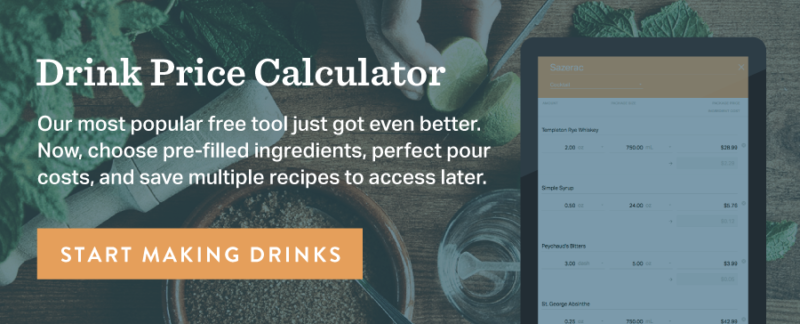
The Siren Song of Ready Made
A big box liquor store’s cocktail prep aisle is a pretty standardized experience. Bottles of simple syrup, bitters in vintage dropper bottles, and margarita mix so bright it could give you radiation poisoning line the aisle in simple, neat rows as far as the eye can see.
The lure of the ready made cocktail mix or store bought bitters and syrup is strong. It cuts down on labor. It’s factory-produced so the flavor will be the same every single time. Processed goods like those keep for years if they’re stored properly. There’s a lot to be gained in terms of time from buying individual cocktail ingredients rather than taking the diligence to make them yourselves.
Depending on the type of bar, it also may not make a difference in taste to the customer. If your clientele isn’t the discerning craft cocktail connoisseur, the difference between using a mix and using fresh made ingredients may not be apparent, which means the labor gone into creating the homemade mix will have basically been wasted.
While the road of ready-made ingredients might seem appealing to some of you, let me tell you why that shouldn’t be the attitude you carry toward fresh in-house cocktail ingredients.
The Way of the DIY
The immediate obvious benefit of in-house ingredients is quality control. When I first started making cocktails, I always used store-bought syrup. It was easy, it was cheap. I thought that syrup was syrup, it just added sweetness. And then I reviewed The Dead Rabbit Drinks Manual and made my own. It was fresh, it wasn’t preserved and processed, and it just instantly made everything better.
But that’s just for one person right? Surely for a busy bar it’s easier to just buy in bulk and move on with your day? Not quite. DIY cocktail ingredients (syrups, bitters, batch drink mixes, etc) can actually be made quickly, easily, and for pennies on the dollar. What’s more, for the creative bartender they are endlessly customizable and keep your menu fresh.
If you are looking at the pure financial costs, as an example, simple syrup can cost anywhere from five to fifteen dollars for a 32oz bottle. For the same price, you can produce gallons of the stuff by combining sugar and water over low heat, and it’ll store for up to a month. Imbibe actually has a cheat sheet for over fifty different kinds of easy to make syrup, and a clever bartender will always find new recipes to alter and enhance their repertoire of drinks.
The Bitter End
The same philosophy goes for bitters as well. While some bars may find it a small challenge to lay their hands on fresh gentian root or cassia bark, most grocery stores carry a wide array of ingredients that can be put to use in making unique and flavorful bitters. These require a little more time than syrups, often taking several weeks to properly infuse, but require almost no effort to create. Simply shake daily to insure proper blend of flavors and enjoy. What’s more bitters keep pretty much forever because of their high alcohol content, so you’ll only need to make them as often as you use them.
Beyond low cost and ease of creation, making your own cocktail ingredients by hand offers the benefit of creating bartenders who are better able to identify and use individual flavors in pursuit of a greater whole. Experimentation with the five types of flavors (sweet, salty, bitter, sour, umami) leads to a greater understanding of how they work and how to make the best use of them than just pouring from a premixed jar. In the end, this helps your bartenders craft a style and flavor specific to your bar, one that will separate your bar from the madding crowd.
When you craft your own cocktail ingredients, from bitters to syrups to batch mixes, you have an opportunity not to just showcase your bars sense of style and flavor, but that you care enough to craft a perfect experience, every cocktail, right down to the minutiae. Yes, it takes work to craft them on a week to week, month to month basis, but the end result adds another layer of personality to your bar that customers will notice and appreciate.
Schedule 15mins to chat with a product specialist
Start a FREE Trial Today! BevSpot offers full product education and account setup for all customers! No card Information needed!
For more info on bar management techniques, stay tuned to the BevSpot blog by creating your own personal account. You’ll get notifications when we post new articles, as well as exclusive access to our industry tools and guides.
How to Price Your Wine By The Glass
Getting the most out of the prices for your wine by the glass offerings can be a constant battle.
Offering wine by the glass is fairly standard in most establishments. It’s a great option for guests who want to try different wines and/or don’t want to feel obligated to order full bottles. Still, it can feel like there are a multitude of approaches to choosing what to offer by the glass and, more specifically, pricing these offerings. Here’s what you need to consider when deciding how to price wine by the glass.
Start Your Free Trial With Bevspot Today!
The Basics of Pricing Wine by the Bottle
Before we dive into the specifics of wine by the glass, let’s briefly cover how to price wine by the bottle.
Most on-premise establishments price wine bottles at four to five times the wholesale price of the bottle. (This means a pour cost of ~20-25%, or profit margins of ~75-80%, not accounting for variance/waste.)
But when you start reaching around or above $30-50 per bottle, this rule might not be effective for your clientele. Some establishments will set lower prices, depending on how quickly they want to go through bottles and the level of demand for those bottles.
Every establishment will experiment a bit with pricing, especially if they are new and just getting to know their customer base. Now that we’ve briefly covered wine by the bottle, let’s go over how to price wine by the glass…
Know Your Clientele And Your Limits
As I said when discussing distributor sales reps, you should know your business better than anyone.
That means you should know your clientele. When it comes to pricing, you should know how much is too expensive for your customers, and how low you are willing to set prices. Knowing these will help guide you in determining what wines to feature in your program as offerings by the glass. In my experience, most bars will comfortably price wine by the glass at around $9-15 per glass.
(Note: There are many outside factors that will affect the scope of this range such as your establishment’s location and its competitive environment.)
You also need to know the limits of your wine. Once you open a bottle to pour a glass, it won’t last as long as one that is fully corked and sitting in your bar inventory. This heightened need to get your money back on that bottle will influence your pricing decisions.
Pricing Wine by the Glass
The pour cost of your glass pour should be the same as the wholesale cost of one bottle—that is, about 20-25%.
If you follow this rule, you should make your money back on a whole case of wine after selling just 3 bottles or 12 glasses of wine (assuming four 6oz glasses per bottle).
There are a few exceptions to this approach:
- If the bottle you are pouring costs less than your lowest price limit for wine by the glass (e.g. your bottle costs $6, but you want your cheapest wine to be $9/glass), you should try to price it at your lowest price limit instead. This way everything stays consistent and you are able to make a little more per glass on that bottle of wine. The caveat to this is if your local competitors carry the same wine at a lower price by the glass.
- If the bottle you are pouring costs more than your highest price limit for wine by the glass (e.g. your bottle costs $18, but you don’t want to price your wines higher than $15/glass), you can either price it at your highest price limit and sacrifice your profit margins on that bottle. The alternative is not to offer the wine by the glass.
Finishing Notes
If you’re struggling to find bottles of wine to fit into your limits, work with your distributor sales reps and do your own research. Your desired wine selections should never override your own limits.
Like a painter working within a defined canvas layout, the art of curating a great wine list is aided with limits. There are countless wineries across the world and the struggle of choosing the right ones to feature are made easier by these kinds of boundaries you make for yourself.
Start a FREE Trial Today! BevSpot offers full product education and account setup for all customers! No card Information needed!
or
Schedule 15mins to chat with a product specialist
What Your Bar Needs to Know About Navigating Craft Beer in the Buyout Era
In response to the purchasing of a popular craft brewery by ‘Big Beer’, which side should bars take?
This past May, Anheuser-Busch InBev added to its stable of craft beer brands by acquiring Wicked Weed of Asheville, North Carolina. In many ways, the deal was entirely unsurprising. The world’s largest brewery is in the midst of a multi-year spending spree, which has seen it gobble up a number of once independent breweries all over the map. The reaction, too, was unsurprising. Just like with deals past, brewers spoke out, incensed that a company they believe actively works to hurt craft beer was again buying its way into the space.
This time, though, the rebuke was a bit more forceful and came from more than just brewers. In fact, in light of the Wicked Weed transaction, breweries found themselves suddenly joined by a notable chorus of bars and restaurants, echoing their dissent, with many beer joints publicly vowing to no longer carry any products owned by AB InBev. It was bars and restaurants officially taking up metaphoric arms alongside brewers in the war against Big Beer. And these are the businesses we’d like to focus on today. Because if a bar wants to vocalize allyship with small brewers on this issue, there are serious considerations they need to make to ensure the stance isn’t an empty gesture or grounded in hypocrisy.
For starters, and perhaps most importantly, there’s the matter of quality.
It’s not controversial to say that Wicked Weed makes genuinely amazing beer. But don’t take it from me. Take it from Jeffrey Stuffings, of Jester King, a similarly renowned brewery in Austin, Texas. His company swore off the brand, removing it from its own taproom in light of the sale, but no less believes in its quality. “We think Wicked Weed beer is some of the best in the world,” he wrote at the time of the sale. “Their talent, techniques, and patience produces some of the most beautiful beer we’ve ever tasted.”
And, contrary to what your average Facebook commenter might have you to believe, that’s not likely to change one iota now that AB InBev owns the company. Not to mention, selling to a conglomerate–or private equity firm or other craft brewery–can help not only line entrepreneurs’ pockets, these deals can create new roads to growth. As such, it’s important to remember, if this is a hill you want to fight on as a bar or restaurant, it could mean willfully rejecting what is considered objectively good beer.
More than that, though, taking this stand is a question of ethical principle, and whether that ethical principle outweighs your driving desire to stock certain high quality beers.
To that end, you should think about what such a proclamation might mean for your business, not in the moment itself, but going forward. Ask yourself, “What will I do if and when I wake up one day to learn that AB InBev has acquired a brand that has proven important to my program? Will I stop stocking it and lose an important source of revenue? Or will I revisit our policy?”
Simply put, making this type of statement from afar and in response to a piece of news is easy. It’s much more difficult to walk back the statement when the corporation behind the King of Beers signs a check your business can’t cash.
Quality and ethics aren’t the only issue to think about though.
In fact, to swear off AB InBev products entirely is to open a whole gigantic can of worms about ownership and independence in general.
And if you don’t know your stuff–or if you enforce these types of blacklists inconsistently or arbitrarily–you risk appearing both ill informed and hypocritical.
It’s true, many craft breweries consider AB InBev an enemy to their own cause. But it’s hardly the only company you could call “Big Beer,” and it’s hardly the only company making everyone feel uncomfortable by buying into the space. So if you want to throw the gauntlet down against AB InBev, be prepared to follow the money elsewhere, too.
For instance, if you’re unwilling to carry beer from the likes of Wicked Weed (or Golden Road, Elysian, Goose Island, Devil’s Backbone, or any other AB InBev “High End” brand), but are willing to carry beer from the likes of other formerly independent craft beer darlings, be prepared to explain your reasoning.
If you carry Founders, which sold a minority stake to Mahou San Miguel, Spain’s largest brewer, back in 2014, or Lagunitas, which sold a stake to Heineken in 2015 before selling the rest of the company this past spring, but not AB InBev products, why? Why stock one but not the other? There could be legitimate reasons to maintain some flexibility in your stance on independence as it relates to what you carry. Not all businesses operate the same and you may be comfortable with the practices of one and not another. That’s fine. Just be sure you know what those reasons are.
This has played out already. Earlier this year, I reported a story about a budding boycott of Ballast Point in Chicago. Bars had by and large been okay with the fact that Constellation Brands had recently acquired the company. Then they caught wind of Constellation’s own lobbying efforts in Washington, D.C. and suddenly Ballast Point became a target. “We’re gonna have to start holding these brands like Ballast Point accountable for the decisions that they make and the people that they align themselves with,” Dale Lewis, owner of Minor Threat, told me at the time.
This is all to say, the business of beer has never been more complicated. And it’s okay to feel strongly about which businesses are owned by which other businesses. But if you make this concern a part of your bar or restaurant’s public-facing identity, it’s crucial to consider what you’re saying, how you’re saying it, and why.
What do you think? How should bars navigate the muddy waters of serving craft beer in the buyout era? Let us know in the comments section below.
For more insight into bar management techniques and how to get the most out of your bar, keep up with the BevSpot blog by creating your personal account. You’ll get notifications when we post new articles, as well as exclusive access to our industry tools and guides.
6 Pro Tips From Musicians for Hosting Live Music at Your Establishment
Alcohol and live music is one of the most natural, time-honored pairings in the bar and restaurant industry.
Done right, it can create memorable, engaging evenings that draw in eager crowds.
Done wrong, it can be an expensive disaster.
Providence has a vibrant music scene for a small city, so I asked a few of our local musicians to provide advice about the best ways for bar owners and staff to interact with musicians and to make it a successful venture for both parties:
1. Know your space and your clientele, and hire bands that are a good fit.
This requires you to be very self aware of your space, its vibe, and the types of people who frequent it. Hiring an industrial band to play for a mostly Baby Boomer audience might not be your best bet, for instance.
“Please don’t hire a band and then try to dictate what they can or cannot play,” says Amato Zinno, a full time musician who plays primarily bass with multiple bands including The Z-Boys. “It gets awkward and can take the wind out of a band’s sails. It’s okay to tell a band to turn down, but if you have to do it all the time, maybe it’s not the right band for your space, or maybe you’re not meant to have music. And that’s okay.”
2. Hire a band on a night that you are trying to bring more people in.
“The band will be psyched to have a gig on a night that they don’t normally work, and will be more motivated to get more people there to see them,” says Amato.
One thing I asked was how much of the onus should fall on the band versus the venue in terms of bringing people into the establishment. Pretty much everyone I spoke to felt that it was a shared responsibility and that, ideally, both parties work hand-in-hand to promote the event, which brings me to my next rule:
3. Pay fairly and do your part in helping to promote the show.
Keith McCurdy, guitarist and singer for the band Vudu Sister, feels that guaranteed payments for musicians are preferable to door splits, because “it urges venues to promote more. Musicians will (typically) promote their own shows regardless.” He says that venues can be stubborn in this regard, and that with a door split, “Hey, if nobody shows, the musician doesn’t get paid. No real sweat off the venue’s back.”
Steve DelMonico, singer and guitarist for The Quahogs, has been playing live shows since 2010; he’s also a bartender, so he knows both sides of this equation. Steve is of the mind that bands typically “pay their dues” starting out and work their way up to better opportunities and guaranteed pay.
“It’s all dependent on where you’re at draw-wise,” he says. “If you have a decent draw, you should be getting a guarantee. If you’re just starting out, you’re just hoping to get on a show, and promoting is part of your job. I think that it’s always good when bars and venues make posters for you, but, if they don’t, then you kinda gotta pull the weight.”
This is a fair assumption, but it seems that bottom line, both bands and musicians benefit from greater attendance when both parties help to promote.
4. Do host an open mic or jam session, but don’t host it on the weekend.
“Open mics are cool ways to engage the musical community in your town,” says Amato, but if you host it on the weekend, “It’s a sure sign that you’re not about music and are really grasping at ways to get people into your bar. It’s my biggest pet peeve. Sunday to Wednesday is acceptable, but if you’re a place trying to host music, I don’t think an open mic or jam is really okay unless you’re having music other nights of the week.”
5. Never have a touring band headline, be responsive, and have your promoter link all of the bands playing in one night together ahead of time.
“You always have to take care of the touring band; having them in the middle is key,” says Steve. “You also need a sound person who cares about and knows what they’re doing. A lot of the time I’ll be asking about something, my monitor or whatever, and the guy’s not even responding.”
He also notes that it’s necessary to link any bands playing the same night together before the show so that they can converse ahead of time to sort out the back line setup for the night: base rig, drums, etc.
Also, and this should be obvious: never double-book bands. “Nothing is more of a drag than showing up to a gig and finding out you’re not working,” says Amato. “If you do it, tell a band as soon as you know; otherwise, be prepared to compensate at least a portion of what you offered them as payment. Word travels fast [in the musician community], and if you’re careless about this, no good band will want to play your establishment.”
Be cognizant of timing. Steve cited an evening where his band was scheduled to play but couldn’t get onstage until 15 minutes before closing because another band ran way over. Amato has had experiences where people were still chatting and eating at 9:40 at tables which needed to be cleared before his band was supposed to go on at 10:00. There will always be unpredictable elements, and musicians are musicians, after all; sometimes bands take a long time setting up or breaking down. Just try to expect the unexpected as much as possible and plan accordingly to try to minimize SNAFUs.
6. Take care of drinks, or at least be clear up front about your policy.
“I feel like every venue should accommodate some types of drinks for musicians, and/or food if you have it,” says Steve. As a bartender, he does add the disclaimer: “But musicians should always tip. I do. But don’t expect much of a tip from a touring band, because they don’t have money.”
“Be clear at the outset about any food/drink policy you may have,” is Amato’s take on it. “Giving a band a tab or offering them a free meal goes a long way to making them feel at home and wanting to play at your place again. Figure out what you can offer and communicate that up front.”
In this list, I didn’t include the (hopefully) obvious advice that a venue should always be set up to host live music with enough space and all of the necessary equipment, or if you don’t have your own PA/sound system there, make sure you ask the musicians ahead of booking whether they can bring one. This is basic common sense and good business, along with researching bands thoroughly enough ahead of time to know what type of music is a good fit for your establishment.
Ultimately, if you can find bands and musicians that are a great fit for your venue and who work well with you, and, if you pay them fairly and both parties do their part in promoting, you can end up with a great night of memorable music that is sure to bring in new and returning guests.
For more insight into bar management techniques and how to get the most out of your bar, keep up with the BevSpot blog by creating your personal account. You’ll get notifications when we post new articles, as well as exclusive access to our industry tools and guides.
Schedule 15mins to chat with a product specialist
Start a FREE Trial Today! BevSpot offers full product education and account setup for all customers! No card Information needed!
The 7 Most Popular Cocktails on BevSpot’s Drink Price Calculator
BevSpot’s Drink Price Calculator
Drink pricing continues to be one of the most important drivers of a bar’s profitability, and thus one of a bar manager’s biggest challenges. We built our Drink Price Calculator to make that problem easier to solve for the industry. And so far, users have responded: tens of thousands of cocktails, wine glasses, draught beers, and shots have been priced and repriced for drink menus around the world.
These drink recipes provide a glimpse of the drinks that bar managers are tinkering with. And as the data makes clear, some drinks are more prevalent on the Drink Pricing Calculator than others.
Why? Managers sometimes focus on particular drinks because they serve them more often. Sometimes it’s because they present more opportunities for experimentation. And sometimes it’s because they represent the biggest opportunity to reduce pour cost.
Whatever the reason, we wanted to analyze the data to see which cocktails were being priced the most often. These are the most popular cocktails on BevSpot’s Drink Price Calculator.
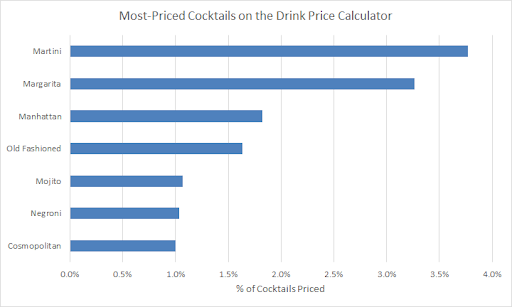
1: Martini (3.8% of Cocktails Priced)
Accounting for almost 4% of cocktail recipes, the Martini is popular on the Drink Price Calculator not just because it’s so well-known, but also because it’s so easy to experiment with. We don’t just see users trying out recipes with different gin brands, but with different vodka brands.
We also see various concoctions of the drink that experiment with adding additional flavors: recipes for Espresso, Apple, and Chocolate Martinis are some of the most prolific. With so many ways to mess with the formula, it’s no surprise that this is the most commonly-priced cocktail.
2: Margarita (3.3% of Cocktails Priced)
The Margarita is a popular drink, though not as broadly so as, say, the Manhattan or Old Fashioned. But while bars are unlikely to brand themselves “Manhattan bars” or “Old Fashioned bars,” evidence suggests that a segment of the industry does specialize in Margaritas.
And of the bars that do specialize, there are often many, many variations. Not just between tequila brands like Patron, Jose Cuervo, or Patron, but between different flavors, usually fruit-based: Blood Orange, Cucumber, and Raspberry Margaritas are common variations.
3: Manhattan (1.8% of Cocktails Priced)
As we’ve shown before, the Manhattan is one of the most costly classic cocktails, mostly owing to the whiskey that accounts for 60-70% of the drink by volume.
Because the whiskey presents the biggest opportunity for improving the recipe’s pour cost, it’s unsurprising that much of the variation we see among Manhattan’s on the Drink Price Calculator comes from the choice of whiskey brand: Bulleit, Rittenhouse, Seagram’s, and many more.
4: Old Fashioned (1.6% of Cocktails Priced)
Many of the cocktails on this list see heavy use on our Drink Price Calculator because they have many recipe variations. Margaritas, for example, are common subjects for bartenders’ experimentation along dimensions of tequila brand, tequila type, and flavor.
The Old Fashioned is different. Variations on the original cocktail are rare, though they do exist. This drink makes the top 7 cocktails on our Drink Price Calculator because it’s so prolific.
5: Mojito (1.1% of Cocktails Priced)
The Mojito is another classic recipe that commonly sees experimentation with fruit infusions. Commonly-used fruit flavors include guava, pear, and strawberry.
6: Negroni (1.0% of Cocktails Priced)
Since it’s only become popular stateside within the past few years, we don’t see much divergence from the “classic” Negroni on the Drink Price Calculator; more than 70% of Negroni cocktail recipes we observed were for the original recipe.
7: Cosmopolitan (1.0% of Cocktails Priced)
It may not be the ‘90s anymore, but the Cosmo is still an ubiquitous request for bartenders everywhere.
Though not to the same extent as with other cocktails on this list, we do see bar managers experimenting with their recipes for this drink: trying different vodka brands, using the French and Dutch variants, or even adding grapefruit or blood orange into the mix. And since the cocktail’s one of the more-profitable classic vodka cocktails, it might be worth trying to sell a few more.
Schedule 15mins to chat with a product specialist
Start a FREE Trial Today! BevSpot offers full product education and account setup for all customers! No card Information needed!

The following material aggregates about five months of Drink Price Calculator user data ending in May 2017. 86% of these users were located in the United States and Canada. All figures represent percentages of cocktail recipes priced using the tool.
4 Steps To Set Up A Bar Team and Minimize Management Involvement
What do you think of when you hear the word, “team”?
For me, it brings to mind a group of people working together to achieve a goal. What I don’t think of? A manager front and center. (Seems pretty odd when all I write about is management, right?)
Every team does need a manager, a coach, a leader. There’s no doubt that someone on the fringe can provide excellent perspective and guidance, but what if I told you your bar team doesn’t constantly need a manager present?
I’ve had the pleasure of working with other people and companies who demonstrated or allowed me to set up a structure that allowed for bar team success. This is where one of the five soft skills I mentioned as essential for bar managers, organization, comes in handy.
Management shouldn’t have to take the role of a babysitter, and, if they are too present with the team, managers often lose their ability to take charge of bigger-picture problems. Bar managers are often also bartenders. When I was a bar manager, I had to split my time between my managerial duties on top of bartending four shifts a week. Because of this, I prioritized training my team to run without me when I wasn’t on-premise as well as when I needed to do work off the bar.
As a result, I was able to send more emails, talk more with distributors, and get more familiar with product loss/waste, and improve the staff further. It only took a few weeks for the staff to realize they were more than capable without someone overseeing them all the time: demonstrating trust in their ability to record spills, put aside voids for me to handle, and handling tough guest situations created better communication and accountability. I also found staff turnover decreased and employees showed up in better spirits (pun intended).
So, how do we set up for bar team success? Here’s some steps to take:
1. Asking the right questions when hiring
Lead bartenders help keep the flow moving and train new members and check in with management so management isn’t stuck on the bar or floor watching every move. Spend some time asking about leadership skills in interviews:
“When it’s just you and a co-worker, and you see they aren’t doing something right, how do you address it if you do? Tell me how you feel about about holding someone else accountable.”
These questions allow for a conversation that better helps me understand what they ideally want to do and where they actually are at. I can get an idea of where I can build them, not just technically, but behaviorally. Most skills, soft and technical, can be taught—the idea is to make sure your lead bartender is someone who demonstrates the ability to change and possesses awareness beyond their own self.
2. Correct compensation
Make sure to compensate your lead bartender for the elevation in position whether through a specific title and/or pay increase, adding to a person’s job description deserves proper compensation. Lead bartenders are valuable and have all the potential to be a manager—there are never enough quality managers.
3. Create thorough to-do list of tasks
Demonstrate the way the tasks should be accomplished and make sure the lead bartender does exactly that as well. Make sure to let them know that list is welcome to change as they figure out what might work and what could be more efficient. A task list is not the end all be all, but a great resource that should provide the teams with guidance without going to management all the time.
4. Communication
Make sure there is a system of accountability that starts with the team before it gets brought to you. Accountability is a must. It’s also one of the tougher traits to establish because people can be conscious about can be conscious about coming off as a jerk or a difficult person to work with. Give examples to your team about how they can hold each other accountable without being too aggressive like:
“Hey, that cocktail looks too red. I totally made that wrong too last week—our manager showed me where my measurement was off. Try using this side of the jigger instead. It has the half ounce marked on it. Want me to put it onto our void sheet while you remake it?”
Figure out which approaches work best for each bartender. Some can handle direct confrontation. Some need a softer touch, possibly in a humorous manner. Others have to be led through a conversation. Demonstrate accountability and be a representation of how the professional isn’t personal. Someone made a mistake, address the situation directly, and let’s all move on.
When bar managers are able to set up for success, we have a better ability to look at the big picture and see more that is getting done and what needs to be addressed. A business can only function as well as the foundation is put together.
Are there other tools you’ve used to successfully structure your bar and minimize management involvement? Let us know in the comments below.
For more insight into bar management techniques and how to get the most out of your bar, keep up with the BevSpot blog by creating your personal account. You’ll get notifications when we post new articles, as well as exclusive access to our industry tools and guides.
How to Build a Healthy Relationship with Your Bar’s Sales Reps
You (should) know your business better than anyone.
Whether you’ve been working with the same bar sales reps for decades or are just starting to work with a brand-new distributor, your superior knowledge of your business makes you the most qualified person to make product purchasing decisions for your bar.
But this doesn’t mean that your liquor, beer, and wine sales reps can’t help you move your business forward. Here are three steps to ensure you get the most out of your distributor relationships, without compromising your own plans or ordering product that simply won’t sell to your clientele.
1. When Evaluating Product Proposals, Consider Your Particular Needs
When sales reps get access to new products in their portfolios, they are often pressured to sell it to as many clients as they can. Your distributor will be trying to prove that their investment in this new product is worthwhile. If your sales reps think it is a good fit for you, they are likely to propose to feature it at your bar.
So, how should you approach these proposals?
Because sales reps have unfettered access to these products, you should be wary if you don’t have similar knowledge about these products as a bar owner/manager. If possible, taste a sample and have them educate you on it. If it’s a new product, keep in mind whether it can be something you can educate your customers about.
You know your business better than anyone else, but be open to new opportunities.
You probably have a better sense of how the product will fit into your selection and whether it will really appeal to your clientele.
That being said, you should never get too comfortable with your existing product selection. That can lead to complacency, which can leave you and your establishment behind the industry’s constantly moving trends.
Take each new product proposal seriously, and do the necessary research to make an informed decision about its fit for your clientele.
2. Research New Products
Naturally, some of that homework will entail market research.
If you took this product, would you be the only establishment in your area offering it? If you would be the only one, why is that? How much benefit/danger/risk is there in introducing it to your market?
And if you wouldn’t be the only establishment offering the product, what lessons can you learn from others who are offering it?
These are only a few of the questions you need to answer in order to properly evaluate this proposal.
This will come down to what fits best with your program, its goals, and your staff. Ultimately, your staff needs to be able to sell new products to your customers with the right amount of knowledge and confidence if you’re going to have any success.
If you or your owner aren’t completely sold on a proposed product, there are alternative options.
You can have your sales rep come in and do a tasting during a service to see how receptive your clientele are to it. If your rep really wants to foster a relationship with you and your establishment, this shouldn’t be a huge stretch of a request for either party. You can also run tests of products yourself by offering limited runs of new products as specials to your clientele.
3. Be Aware of the Different Kinds of Distributor Reps
Something that often gets lost is that this is a business relationship. If you become too friendly with your sales rep and don’t stand your ground as a wine or liquor buyer, you may suddenly have 18 bottles of a random product in storage and no plan of how to use it.
Of course, this is a people business and you can still be friendly with your sales rep. Just remember that trust has to be earned and retained, and you need to be an active participant in these sales.
Some sales reps will actually try to consider your clientele and your mission. Others will be hard enablers, and persistently focus on meeting their own quotas. There is nothing wrong with either approach, but it’s in your interest to be cognizant of the person you are working with. Let them come to you and present their best.
Your sales rep should see trends in your product purchasing decisions, and work to better learn about you and your preferences over time.
As experienced managers and owners will attest, working with a reliable, trustworthy sales rep can feel like a real living partnership. That’s when you know you’ve achieved the relationship you need with your sales reps to get to the next level with your bar.
For more insight into bar management techniques and how to get the most out of your bar, keep up with the BevSpot blog by creating your personal account. You’ll get notifications when we post new articles, as well as exclusive access to our industry tools and guides.
How Should You Host a Trivia Night at Your Bar?
From a slow Tuesday night to the busiest night of the week, bar trivia can pack the house and create a loyal local fan base.
We love bar trivia night. From the ridiculous team names (shoutout to my adopted team Glitter, Sparkles, Magic & Stars) to the competitive atmosphere, bar trivia night is a great way to draw in dozens of patrons for a few hours of eating, drinking, and good times.
Recently, we sat down with and interviewed managers and trivia bosses Stacy Getz, Mark Higgins and Jennifer Reid of Gene McCarthy’s Irish Pub in Buffalo’s famous Old First Ward about their trivia night that packs in the house. And then we prepared to do battle.
The Upside of Useless Knowledge
One of the first things we discussed was what kind of benefits they saw from running a weekly trivia night. The first thing that came up was the incredible customer base they had managed to build through trivia. Not only did they have teams that came back weekly, Mark told me, but teams came from more than twenty miles away specifically because of their trivia night.
Our trivia night was described to me as “slow” by their standards, and it was standing room only. Customers confirmed what Mark, Stacey, and Jennifer told me: some nights, the crowd stretches out onto the patio and stands shoulder to shoulder. The week before I interviewed them, they had 27 teams compared to the 10 or 15 when we were present.
Another benefit, and one that became even more apparent during the competition itself, was the sense of team and camaraderie the night brought out, not just in the patrons but in the staff as well. We came originally to interview and observe, but were invited to join a team almost immediately, something that the staff expressed happened all the time. The teams joked with one another and begged staff for answers as Mark kept the patrons, bartenders, and servers in good spirit.
Finally, the patrons that do come for trivia stay the duration, which for Gene McCarthy’s is two and a half to three hours, spend more money on food and drink, and bring new customers in through word of mouth.
Triumphs and Travails of Trivia Night
Here’s a few things to remember when starting your own trivia night, according to Mark, Stacey, and Jennifer:
Don’t leave it up to just the MC.
To run a successful trivia night, everyone needs to be in on it. An atmosphere like the one Mark, Stacey, and Jenn have cultivated relied on everyone joking with one another, talking up the crowd, and making the environment feel welcoming.
The three of them told me, “When a new team comes in, everyone cheers when they win or politely chides them the rules when they mess up. They buy them a drink and everyone has a great time.”
Do know the ups and downs of hiring an outside company or arranging the night yourself.
Hiring an outside company costs and standardizes the experience, but you’ll likely be guaranteed a quality night. Arranging trivia night in-house allows you to better get to know your patrons, tailor the experience to your establishment, and saves on paying an outside company, but requires more work.
Don’t let it get rowdy.
A short answer format with answer cards keeps everyone from screaming answers, upsetting non-playing customers, and removes judgement calls that could leave teams feeling slighted over who shouted what first. Make it known that any answers in dispute are up solely to the judge, and make sure your judge is as affable as can be.
Do make each night unique.
From Mark, “I try to keep it fresh. Every night might have a base or theme like history or geography, but those could be anything.” Mark handles all of the questions for trivia night, and never takes anything premade off the web. This allows him to scale difficulty and topic every week.
“It’s one of the harder trivia nights you’ll come to,” he says with a knowing smile. Reader, they were. And it added to the night to see only one or two perfect scores for any round all night long, rather than everyone getting seven or eight of eight answers every single time.
Don’t attach weird conditions to your prizes.
Gene McCarthy’s offers the standard gift cards to the top finishers of their trivia night. What they don’t do that we’ve seen other places do is attach conditions as to how those cards can be used and what on. Nothing says “Congratulations on winning, please come back soon” like “Your card can’t be used on appetizers or after nine at night or only when Mercury is in retrograde.” After spending a lot of time and work on making a great night memorable, don’t sour it at the end with fine print.
Do advertise.
From Jennifer, “I do all the social media. We post free questions and categories so teams know what they’re getting into.” That lure of advance knowledge keeps teams checking in regularly, to the point that they call her out when the events don’t post. “They let me know, even if I spell something wrong everyone lets me know.”
After the final round, Glitter, Sparkles, Magic & Stars finished one point off the podium. We still had a blast. We still ate great food and drank great beer. The bar packed in the customers on what they described as “a slower trivia night” and everyone had a great time. Gene McCarthy’s has put in the work of developing a style, promoting an atmosphere, and building a customer base, turning their trivia night into a reliable driving force to get customers in, and ensure they have a memorable night that they’ll talk about with their friends.
If nothing else had told me that these folks did it right, it would be this: I can’t wait to round up a team and come back next week.
Do you have any more tips on how to run a great trivia night? Let us know in the comments below.
For more more insight into bar management techniques and how to get the most out of your bar, keep up with the BevSpot blog by creating your own community account. You’ll get notifications on new articles as well as exclusive access to our industry tools and guides.
Schedule 15mins to chat with a product specialist
Start a FREE Trial Today! BevSpot offers full product education and account setup for all customers! No card Information needed!
What Massachusetts’ New Growler Law Really Means
A recent advisory meant to loosen regulations actually creates new hurdles for the state’s craft brewing industry and the drinkers who support it
Massachusetts’ breweries are well accustomed to working within a regulatory framework that can, charitably, be described as draconian. Late last month, however, the state’s alcohol enforcement agency cut them some legal slack as it relates to the sale of growlers, the popular large glass vessels in which brewers often sell beer to-go in lieu of cans and bottles.
Specifically, the state’s Alcoholic Beverages Control Commission declared that brewers are now free to refill growlers from outside their own inventory. Prior to the update, brewers were only permitted to refill growlers that they themselves originally sold to the drinker (meaning, the only growlers one could fill at, say, Harpoon were growlers originally purchased at Harpoon).
The move, on its face, seemed like the state’s first noteworthy action toward fulfilling its promise of reviewing and streamlining the rules that govern the local alcohol sector. And brewers generally seemed to view it favorably, as the Massachusetts Craft Brewers Guild called it “a great opportunity for many Massachusetts breweries that rely on growlers as their primary source of selling beer to-go.” But, upon closer examination, the utilitarian value of the growler update isn’t entirely clear.
First, the upsides:
Growlers are both costly and cumbersome, meaning they cost brewers considerable financial resources all while occupying vital physical space, which is in short supply for many small beer businesses. By allowing breweries to fill growlers besides their own, the state is affording them more room to breathe – financially, and, quite literally, in the corporeal sense.
“Ordering and storing pallets of growlers and maintaining the supply when business is good can be both expensive and challenging,” says Rob Burns, president of the Guild and the co-founder of Night Shift Brewing in Everett. “We hope this alleviates some of that burden.”
Beyond that, this is also a positive in some ways for the end consumer. Yes, some people take great pride in their vast growler collections. But, many others resent the fact that they have to buy new glassware every time they visit a new brewery if they want to take beer home (because like brewers, drinkers, too, have limited cash and shelf space). This advisory allows them to do that.
That said: There’s reason to believe the advisory could cause some consternation in the marketplace.
For starters, the update doesn’t mean any brewer in the state can fill just any growler. In fact, it would still be illegal for one brewery to fill another brewery’s branded glass. Rather, the advisory specifies that any growler not of a brewery’s own kind must be entirely unbranded. This could pose a couple of problems.
First, it has the potential to create dissidence between consumers and brewers if they aren’t on the same page about a company’s policy.
“…breweries still have the right to decline filling any type of growler, or growlers at all,” adds Burns. “It will be up to the breweries to make their individual policies clear on their website and social media channels to avoid disappointed guests in their tap rooms.”
Furthermore—as previously reported by the Worcester Telegram—by specifying a growler be entirely devoid of branding, the advisory seems to circumvent federal law that mandates such packages come with the familiar Surgeon General’s warning on it.
And these bureaucratic hangups aren’t the only issue with unbranded growlers.
Cleaning them is another. Take the People’s Pint, a brewpub in Greenfield, for instance. When a visitor arrives with a People’s Pint-branded growler, the company will exchange it for a new one, so it can properly clean the old one before reinserting it back into rotation. This, brewmaster Chris Sellers says, ensures the packaged beer tastes as the company intended it to.
Unfortunately, this transaction doesn’t work with unbranded containers. That’s because the visitor would not be able to bring its new People’s Pint growler to be filled elsewhere, thus defeating the entire purpose of the advisory.
“I think some of the challenges are still the same. Many breweries I’ve talked to about it, and ourselves included, definitely want make sure we can fill a growler that’s been well cleaned, and that means they’re free of any debris, stored without a cap on, and hasn’t been cleaned heavily with soap,” says Sellers. “We get a lot of growlers back that tend to be a little funky. People leave a half an inch of beer in a growler and return it.”
Lastly, the growler itself frankly seems to be losing steam.
Late last year, as reported by Draft Magazine, Night Shift sent a newsletter to fans declaring plans to phase out the format.
“Growlers are convenient, but our QA team’s tests confirmed that cans and bottles preserve freshness best,” the company wrote at the time. “In our endless quest to serve a world class product, we decided to focus on the best take-home formats.”
Night Shift isn’t alone. When Notch Brewing opened its new brewery in Salem last year, Boston Magazine reported the company would not offer growlers at all, instead favoring crowlers–which are essentially gigantic aluminum cans–as its to-go package. “We don’t want to have the consumer have the burden to have to bring back the growler,” founder Chris Lohring told Boston Magazine at the time. Asked by BevSpot whether the company would revisit its position on growlers in light of the new advisory, Lohring said the company “will be sticking with the crowler only option.”
“It guarantees the vessel is clean, or removes the burden of our staff cleaning them,” he says.
Today, it remains to be seen what the future of the growler will look like in Massachusetts. But fret not, lawmakers: There are still many other ways you can help Bay State breweries.
For more news on the beverage industry, keep it tuned into the BevSpot blog by signing up for your own community account. You’ll receive notifications on the latest articles as well as exclusive access to industry tools and guides.
Schedule 15mins to chat with a product specialist
Start a FREE Trial Today! BevSpot offers full product education and account setup for all customers! No card Information needed!
